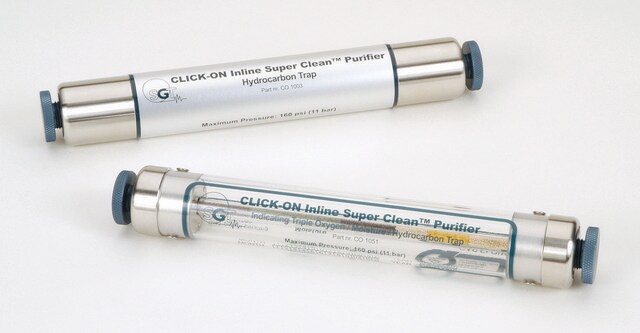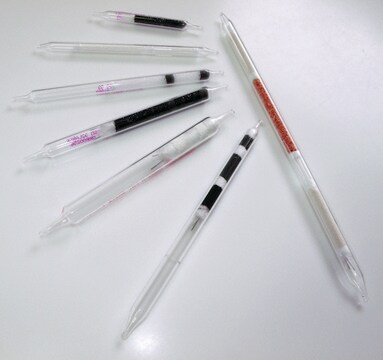10184
Carbosieve Carbon Adsorbent
matrix Carbosieve S-III, 60-80 mesh, bottle of 10 g
About This Item
Produtos recomendados
product name
Carbosieve Adsorbent, matrix Carbosieve S-III, 60-80 mesh, bottle of 10 g
linha de produto
Carbosieve
Nível de qualidade
forma
powder, crystals or granules
embalagem
bottle of 10 g
Parâmetros
400 °C max. temp.
técnica(s)
LPLC: suitable
gas chromatography (GC): suitable
solid phase extraction (SPE): suitable
área da superfície
~975 m2/g
matriz
Carbosieve S-III
Grupo ativo da matriz
carbon
tamanho de partícula
60-80 mesh
tamanho de poro
~0.04 cm3/g mesoporosity
~0.35 cm3/g microporosity
~0 cm3/g macroporosity
~4-11 pore diameter
densidade
~0.66 g/mL (free fall density)
técnica de separação
reversed phase
Descrição geral
- Spherical (better packed bed performance than granular particles)
- Hard and non-friable (pack well, will not break)
- Highly porous (high surface areas)
- Used for molecules with an analyte size relative to C2-C5 n-alkanes
- Hydrophobic (can be used in high humidity environments)
Generally, CMS adsorbents offer greater relative adsorptive strength compared to spherical graphitized polymer carbon (SGPC) and graphitized carbon black (GCB) adsorbents. Our Carbosieve products are a type of CMS adsorbent.
- Have non-tapered pores
- Very strong adsorptive strength due to only containing micropores
- Provide great performance for many small, volatile analytes that most adsorbents have trouble retaining
For more information about any of our specialty carbon adsorbents, please visit sigma-aldrich.com/carbon
Informações legais
Não está encontrando o produto certo?
Experimente o nosso Ferramenta de seleção de produtos.
Código de classe de armazenamento
13 - Non Combustible Solids
Classe de risco de água (WGK)
WGK 3
Ponto de fulgor (°F)
Not applicable
Ponto de fulgor (°C)
Not applicable
Equipamento de proteção individual
Eyeshields, Gloves, type P3 (EN 143) respirator cartridges
Escolha uma das versões mais recentes:
Já possui este produto?
Encontre a documentação dos produtos que você adquiriu recentemente na biblioteca de documentos.
Os clientes também visualizaram
Artigos
Carbon Molecular sieves (CMS) are a versatile range of adsorbents that can be tailored for specific applications. Supelco® scientists have been synthesizing synthetic CMS carbons for several decades, starting from tailoring of the starting polymers/copolymers, to modifying the final properties of the subsequent CMS carbon.
Nossa equipe de cientistas tem experiência em todas as áreas de pesquisa, incluindo Life Sciences, ciência de materiais, síntese química, cromatografia, química analítica e muitas outras.
Entre em contato com a assistência técnica










